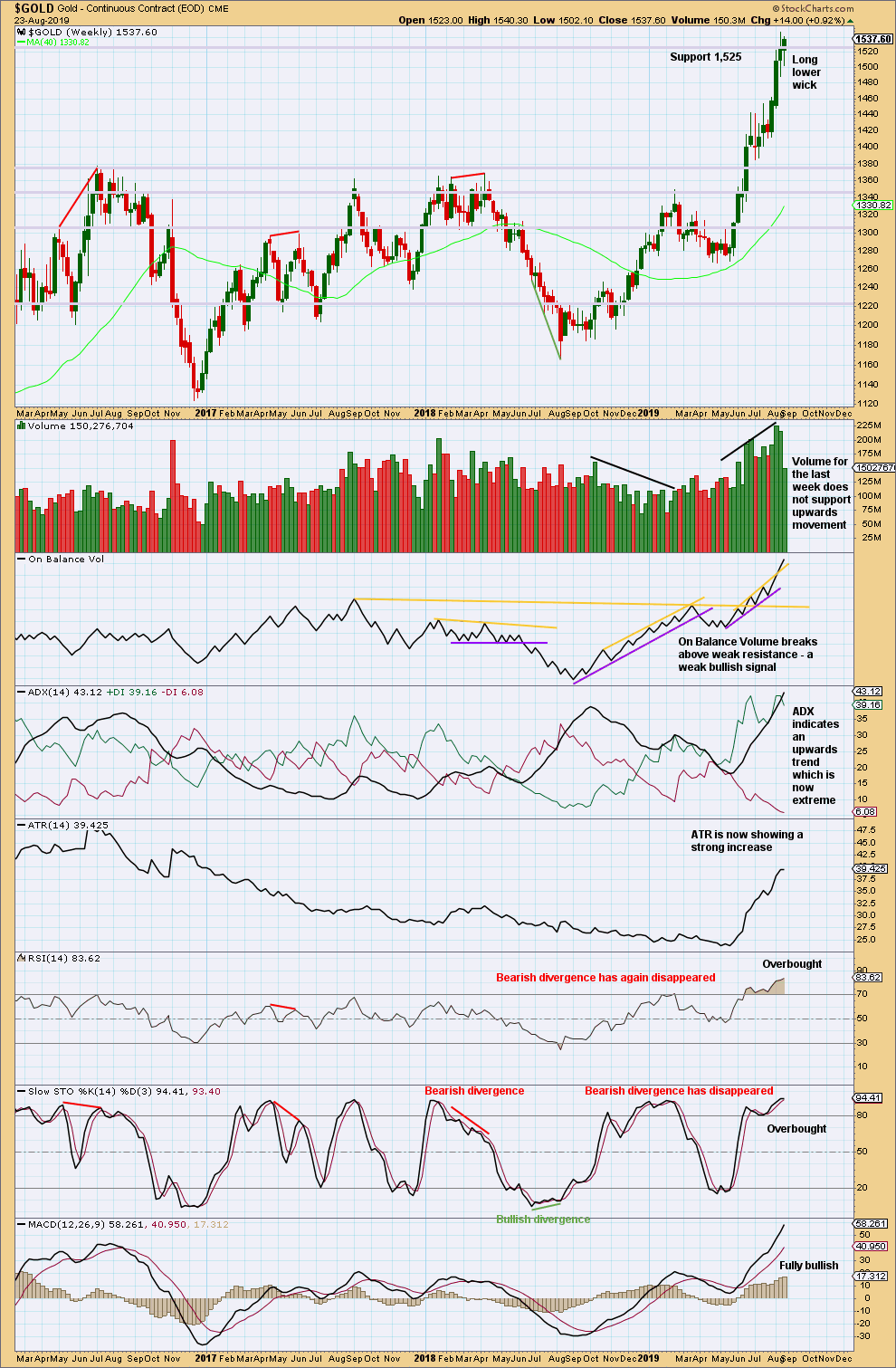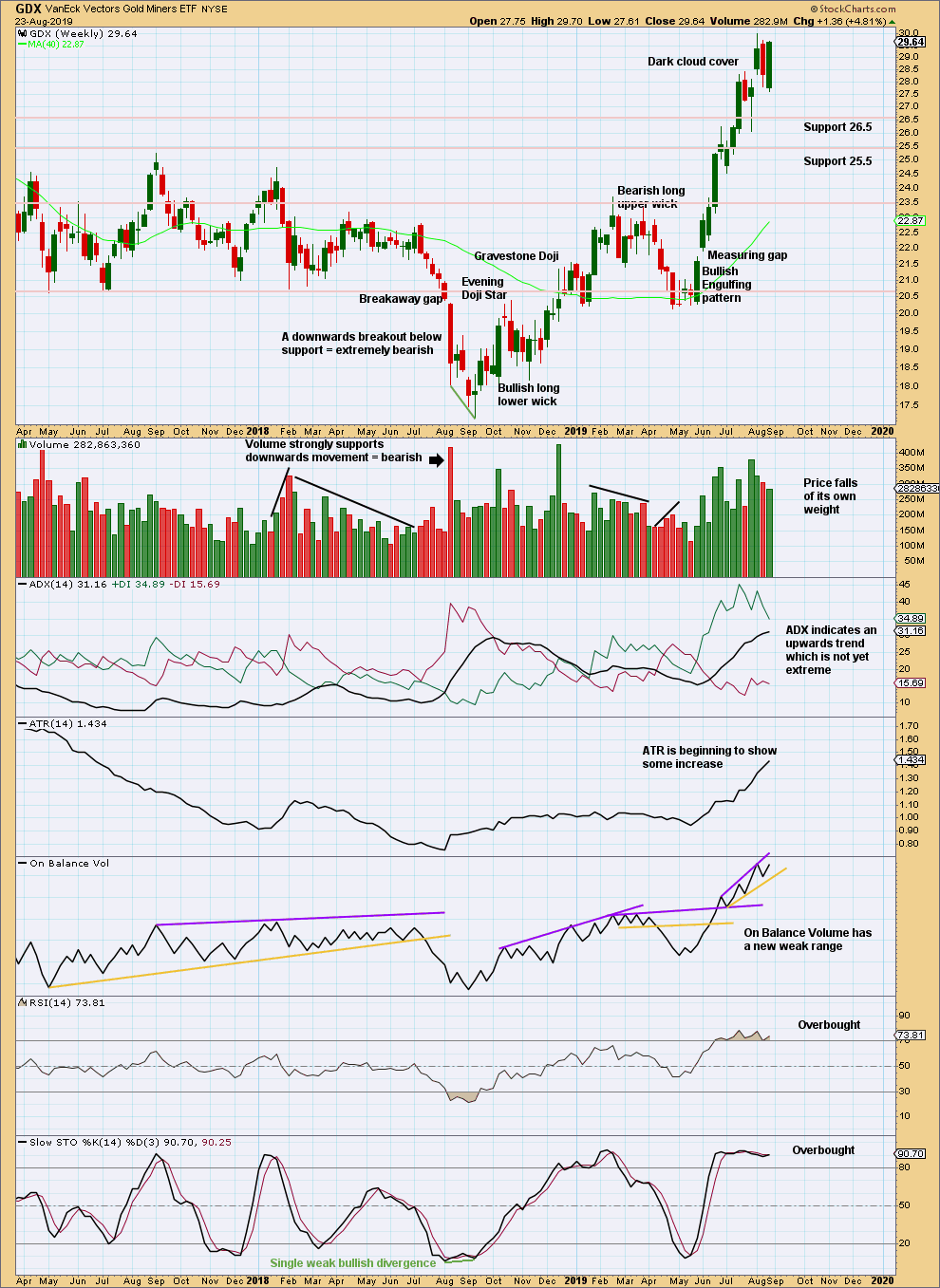For the short term, yesterday’s analysis had three hourly charts which all expected some downwards movement. A red daily candlestick exactly fits this expectation.
Summary: Sideways movement now looks like a small interruption within an ongoing upwards trend that is very extreme and overbought.
If price makes a new high above 1,552.65, then the next target would be at 1,572
A classic analysis target using the pennant pattern is at 1,660. This target may still be optimistic.
The bullish wave count now expects downwards movement for a week or two to 1,469.
It remains possible that a Super Cycle degree trend change occurred at the last high and a new downwards trend to last years may have begun.
Grand SuperCycle analysis is here.
Monthly charts were last published here with video here.
BEARISH ELLIOTT WAVE COUNT
WEEKLY CHART
It is possible that Super Cycle wave (b) is completing as a double zigzag.
The first zigzag in the double is labelled cycle wave w. The double is joined by a three in the opposite direction, a triangle labelled cycle wave x. The second zigzag in the double is labelled cycle wave y.
Cycle wave y may now be a complete zigzag, or it may yet continue a little higher.
The purpose of the second zigzag in a double is to deepen the correction. Cycle wave y has achieved this purpose.
1,481.91 is the start of intermediate wave (5) within primary wave C. A new low below 1,481.91 could not be a second wave correction within intermediate wave (5), so at that stage intermediate wave (5) would have to be over.
1,401.30 is the start of primary wave C. A new low below this point could not be a second wave correction within primary wave C, so at that stage primary wave C would be confirmed as over.
A new low below 1,346.45 would invalidate the bullish wave count below and add confidence to a bearish wave count.
DAILY CHART
Within cycle wave y, the triangle that ended on the 17th of July may have been primary wave B. Primary wave C may have begun there. Primary wave C must subdivide as a five wave structure; it could be a complete impulse.
Within cycle wave y, there is no Fibonacci Ratio between primary waves A and C.
Within primary wave C, intermediate wave (3) is just 0.33 longer than 2.618 the length of intermediate wave (1). If intermediate wave (5) is over at the last high, then it exhibits no Fibonacci ratio to either of intermediate waves (1) or (3).
A breach of the best fit trend channel by downwards movement would be a very strong indication of a major trend change.
There are two hourly charts below. The first follows labelling from this main wave count. The alternate moves the degree of labelling within intermediate wave (5) down one degree and considers the possibility that it was not over at the last high. At this stage, today they are judged to be of about even probability. A breakout is required for confidence in either.
MAIN HOURLY CHART
Intermediate wave (5) may now be a complete five wave impulse.
If there has been a trend change at Super Cycle degree, then a five down should develop at all of hourly, daily and weekly time frames. It would be labelled minor wave 1 at the hourly chart time frame.
Within minor wave 1, minute waves i and ii may be complete and minute wave iii may only subdivide as an impulse. Within minute wave iii, minuette wave (i) may be incomplete and minuette wave (ii) may not move beyond the start of minuette wave (i) above 1,549.46.
ALTERNATE HOURLY CHART
This hourly chart is identical to the main hourly chart with the exception of the degree of labelling within intermediate wave (5). This alternate wave count moves the degree of labelling down one degree. Only minor wave 1 within intermediate wave (5) may be over at the last high.
Minor wave 2 may not move beyond the start of minor wave 1 below 1,481.91. Minor wave 2 may be an incomplete double zigzag. Minor wave 2 may move lower to end closer to the 0.618 Fibonacci ratio of minor wave 1.
Minor wave 2 may not move beyond the start of minor wave 1 below 1,481.91.
The target for Super Cycle wave (b) to end remains the same.
BULLISH ELLIOTT WAVE COUNT
WEEKLY CHART
This wave count sees the the bear market complete at the last major low for Gold in November 2015.
If Gold is in a new bull market, then it should begin with a five wave structure upwards on the weekly chart. However, the biggest problem with this wave count is the structure labelled cycle wave I because this wave count must see it as a five wave structure, but it looks more like a three wave structure.
Commodities often exhibit swift strong fifth waves that force the fourth wave corrections coming just prior and just after to be more brief and shallow than their counterpart second waves. It is unusual for a commodity to exhibit a quick second wave and a more time consuming fourth wave, and this is how cycle wave I is labelled. This wave count still suffers from this very substantial problem, and for this reason the bearish wave count is still considered because it has a better fit in terms of Elliott wave structure.
Cycle wave II subdivides well as a double combination: zigzag – X – expanded flat.
Cycle wave III may have begun. Within cycle wave III, primary waves 1 and 2 may now be complete. Primary wave 3 has now moved above the end of primary wave 1 meeting a core Elliott wave rule. It has now moved far enough to allow room for primary wave 4 to unfold and remain above primary wave 1 price territory. Primary wave 4 may not move into primary wave 1 price territory below 1,346.45.
Cycle wave III so far for this wave count would have been underway now for 54 weeks. It is beginning to exhibit some support from volume and increasing ATR. This wave count now has some support from classic technical analysis.
The channel drawn about cycle wave III is an Elliott channel. Primary wave 4 may find support about the lower edge if it is time consuming enough.
DAILY CHART
Primary wave 4 may be continuing as an expanded flat, which is a common corrective structure. This would see alternation in structure with the zigzag of primary wave 2.
Primary wave 2 lasted 43 sessions. Primary wave 4 may be expected to be more brief; Gold usually exhibits more brief fourth waves than their counterpart second waves. Primary wave 4 may end in a total Fibonacci 21 or 34 sessions. So far it has lasted 12 sessions.
Primary wave 4 may not move into primary wave 1 price territory below 1,346.45.
HOURLY CHART
Within expanded flat corrections, wave B is commonly from 1 to 1.38 times the length of wave A. For this example, intermediate wave (B) is within the most common length.
A target is calculated for intermediate wave (C) to end based upon the most common Fibonacci Ratio to intermediate wave (A) within an expanded flat. This target is just $1 lower than the 0.236 Fibonacci Ratio of primary wave 3 at 1,470.
Intermediate wave (C) must subdivide as a five wave structure. Within intermediate wave (C), minor waves 1 and 2 may now be complete and minor wave 3 may only subdivide as an impulse. Within minor wave 3, minute wave ii may not move beyond the start of minute wave i above 1,549.46.
If this wave count is invalidated in the short term with a new high above 1,549.46, then it would be possible that intermediate wave (B) could be continuing higher as a double zigzag. There is no Elliott wave rule stating a limit for B waves within flats, but there is a convention which sees the idea of a flat discarded when the B wave reaches twice the length if its A wave. For this example, that price point would be at 1,584.77.
TECHNICAL ANALYSIS
WEEKLY CHART

Click chart to enlarge. Chart courtesy of StockCharts.com.
When trends for Gold reach extreme, they can continue still for a few weeks and price can continue for a considerable distance.
When both ADX and RSI reach extreme together, then that is sometimes where a trend ends.
RSI at overbought on the weekly chart is a warning to be cautious; the trend is overbought, but at this stage there is no evidence of a trend change.
Although volume does not support upwards movement, it may be better to judge short-term volume at the daily chart level because much of the last week was taken up by consolidation.
DAILY CHART

Click chart to enlarge. Chart courtesy of StockCharts.com.
A strong Shooting Star pattern with a decline in volume for the session is bearish at least for the short to mid term. Now a downwards session with volume actively pushing price lower indicates continued bearishness.
When trends are very extreme and conditions are overbought, a candlestick reversal pattern should be taken seriously.
Look out for at least a consolidation or pullback to last a few sessions, if not an end to this upwards trend.
GDX WEEKLY CHART

Click chart to enlarge. Chart courtesy of StockCharts.com.
The Bearish Engulfing pattern has been followed by what is technically a downwards week with a slightly lower low and lower high, but this last week has finished very strongly. It looks like the bearish implications of the engulfing pattern may be resolved. There is no evidence on this chart that there has been a trend change. An upwards trend remains intact.
GDX DAILY CHART

Click chart to enlarge. Chart courtesy of StockCharts.com.
The target using the flag pole is at 32.76. This may now not be met.
At this time, StockCharts will not allow me to save the changes to the notation on the chart. Therefore, comments for this chart are below:
There is now an Evening Star candlestick pattern at the high.
Volume today actively pushes price lower. This is bearish.
There is bearish divergence between price and On Balance Volume. On Balance Volume is constrained.
Stochastics is overbought.
Conclusion: GDX may have seen a trend change to either sideways for a consolidation or downwards for a new trend.
Published @ 08:55 p.m. EST.
—
Careful risk management protects your trading account(s).
Follow my two Golden Rules:
1. Always trade with stops.
2. Risk only 1-5% of equity on any one trade.
—
New updates to this analysis are in bold.








Inlight of very bullish sentiment in the market for PM sector the EW count projection appears to be very contrarian :
Lara: “It remains possible that a Super Cycle degree trend change occurred at the last high and a new downwards trend to last years may have begun.”
So it is a tug of war between bullish and bear count.
Thanks Lara for great work. I enjoy your analysis.
It matters not what I think or want, as I’d prefer the bear market so we can short the bugger, and buy back cheap … But a lot of people are saying that gold is already in a bull market in most markets, it’s just the strong dollar hiding its strength in USD.
I’m still praying for the bear to come out though …
Thanks guys.
Apologies for not being here to give updated hourly charts prior to Friday’s close. I’ve not been well. Am much better and doing end of week analysis now, should be published shortly.